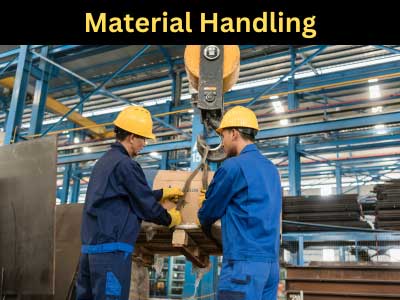Key Takeaway
Material automation, also known as automated material handling (AMH), refers to using automated systems and equipment to manage materials within manufacturing facilities, warehouses, and distribution centers. This includes transporting, sorting, organizing, and storing materials. Automated systems like conveyors, robots, and automated storage and retrieval systems (AS/RS) make these processes more efficient and reduce the need for manual labor.
Implementing material automation improves productivity, accuracy, and safety in handling materials. It reduces human error, speeds up processes, and can operate continuously without fatigue. This leads to cost savings and better inventory management. In essence, material automation streamlines operations, ensuring materials are handled quickly and accurately from start to finish.
Introduction to Material Automation in Industry
Material automation has revolutionized the way industries handle raw materials, semi-finished products, and final goods. In traditional setups, workers were responsible for manually transporting, loading, and unloading materials. This often led to bottlenecks, inconsistencies, and safety risks. Automation eliminates these issues by introducing machines and systems capable of handling these tasks with precision and speed.
In industries like automotive, electronics, and consumer goods, automation systems have taken over critical material handling processes, ensuring that materials are moved from one stage to another without delays. For example, robots are now used in warehouses for sorting and organizing goods, while AGVs are responsible for delivering components to different parts of the production line. This has allowed manufacturers to focus on optimizing production rather than worrying about the movement of materials.

Key Components of a Material Automation System
A material automation system consists of several key components working together to create a seamless flow of materials. Robotics is often at the heart of these systems, with automated robots performing tasks like picking, placing, and moving items. Conveyors help in the continuous movement of goods along production lines, while AGVs transport materials from one location to another without the need for manual handling.
Additionally, sensors and control systems play a critical role in monitoring and adjusting the flow of materials. These systems ensure that materials are delivered in the right quantities and at the right time, helping to prevent delays and improve productivity. Automation software integrates all these components, providing centralized control over material handling and ensuring that the entire process runs smoothly.
Benefits of Material Automation in Manufacturing
One of the most significant benefits of material automation is the reduction in labor costs. By automating manual tasks such as material handling, manufacturers can significantly lower their dependency on human labor, reducing errors and improving efficiency. Automated systems are also faster and more consistent than human workers, ensuring that materials are handled accurately and on time.
Another key benefit is enhanced safety. Automated systems reduce the need for workers to interact with heavy machinery or hazardous materials, minimizing the risk of workplace accidents. Furthermore, automation enables better use of resources. By reducing the time required for material handling, manufacturers can shorten production cycles and improve throughput, which leads to increased production capacity without the need for additional equipment or labor.
How Material Automation Increases Throughput and Reduces Waste
Material automation systems are designed to optimize the movement of materials through manufacturing facilities. By automating tasks that were previously manual, companies can maintain a consistent flow of materials, preventing delays and production bottlenecks. This increase in throughput allows manufacturers to complete more work in less time, ultimately improving overall productivity.
In addition to improving throughput, material automation also helps reduce waste. Automated systems handle materials with precision, reducing the chances of damage or mishandling. Furthermore, by optimizing the use of materials, these systems prevent overproduction and excess inventory. Manufacturers can better monitor and control their material usage, ensuring that nothing is wasted during production.
Future Trends in Material Automation for Smart Factories
The future of material automation is set to evolve further with advancements in technologies such as artificial intelligence (AI), machine learning (ML), and the Internet of Things (IoT). Smart factories will rely on real-time data analytics and AI to make decisions on material handling, adjusting the flow of materials based on current demand and production requirements. This level of intelligence in material automation will result in even greater efficiency and resource optimization.
Robotics is another area expected to see significant innovation. Autonomous mobile robots (AMRs), for instance, offer flexibility in material handling, navigating dynamic environments without the need for predefined routes. Furthermore, as IoT-enabled devices become more prevalent, manufacturers will have access to more detailed insights into material handling processes, enabling them to make continuous improvements. These future trends will drive the next phase of automation, making smart factories the norm in manufacturing.
Conclusion
Material automation is revolutionizing the way industries handle the movement of materials, providing significant benefits such as increased efficiency, reduced operational costs, and enhanced safety. By incorporating technologies like robotics, Automated Guided Vehicles (AGVs), and intelligent control systems, manufacturers can automate repetitive and manual tasks, leading to faster and more consistent material flow. This automation not only reduces human error but also minimizes waste, ensuring that materials are used more effectively.
As industries transition to smart factories, emerging technologies like Artificial Intelligence (AI), Machine Learning (ML), and the Internet of Things (IoT) will further enhance material automation. These advancements will provide real-time insights and predictive capabilities, allowing businesses to optimize their operations continuously. Embracing automation is crucial for manufacturers aiming to stay competitive in today’s evolving industrial landscape.
